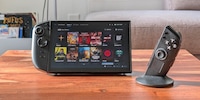

Better thanks to SteamOS: Lenovo Legion Go S review
The Lenovo Legion Go S is the first handheld to officially have the same operating system as the Steam Deck. This makes Windows alternatives look old.
Windows 11 and handhelds don’t go together. Microsoft has also recognised this and introduced a slimmed-down Windows with two Asus devices. However, it’ll be a few months before we see whether this is a success or not. Compare this to Valve’s SteamOS, which has been ready to launch for three years. Unlike with Window’s, Steam Deck’s operating system runs on Linux and was specially developed for handhelds.
Now Lenovo’s Legion Go S is the first portable mini PC to be officially equipped with SteamOS. Originally, this version was to be cheaper than the one with Windows, because of the higher licence fees. However, because the Windows version has already been available for a few months and the price has fallen, the models now practically cost the same.

Unlike when you manually install SteamOS on your handheld via the Linux distribution Bazzite, you don’t have to get your hands dirty with the Legion Go S. The set-up couldn’t be easier. If you already have a Steam account, all you have to do is log in after starting up and the device will be ready to use in just a few minutes.
Solid features
I’ve never come across a handheld I’d describe as beautiful, including the Switch 2. It’s like smartphones: if the screen takes up 90 per cent of the surface, there’s not much room for manoeuvre visually speaking. Lenovo’s game brick makes the best of it, but it won’t win any design awards. Even the LEDs below the analogue sticks are of no use. Incidentally, they can’t be adjusted or deactivated without an additional plugin. But what’s more important, is what’s under the hood:
- Display: 8-inch, IPS, 1920 × 1200 pixels, 500 nits, 120 Hz
- CPU: AMD Ryzen Z1 Extreme
- RAM: 32 GB LPDDR5X-6400
- Storage: 1 TB M.2 2242 PCIe 4.0, microSD slot
- TDP: 30 W
- Battery: 55.5 Wh
- Ports: 2 × USB-C 4.0, 3.5 mm headphone socket
- Connectivity: Bluetooth 5.3, Wi-Fi 6E
- Weight: 730 g
- Misc.: mini touchpad
The Windows and SteamOS versions of the Legion Go S are identical in terms of hardware. There are different versions when it comes to RAM, memory and CPU. I’m testing the model with the AMD CPU Ryzen Z1 Extreme. The same as in the Legion Go and the ROG Ally X. There’s also a cheaper version with the Ryzen Z2 Go. The rest of the kit is comparable to most other handhelds.
SteamOS instead of Windows
The most important reason to buy the Legion Go S is SteamOS. With the Steam Deck, Valve showcases what an operating system for a handheld should look like. The company has now also recently made the OS available for other devices. Lenovo’s handheld is the first to officially benefit from this.
As a result, the user experience is identical to that of the Steam Deck. There’s no bloatware, as with the Windows version. Instead, I’m met with a sleek interface where I can directly install and launch my Steam games. I use the button with the three dots to the right of the display to open the quick settings. That’s where I can adjust the brightness, start chats or select performance profiles. The latter is one of the few differences to the Steam Deck. I can set the CPU clock frequency or the TDP manually, but there are no predefined performance profiles.
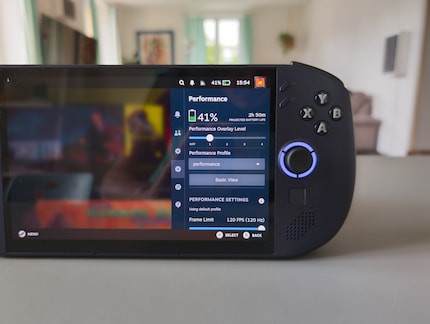
Desktop mode is also available. I use it to install other launchers, such as Battle.net and other software not available on Steam.
The OS operating system is clearly superior to Windows 11, with a navigation designed for handhelds. I don’t have to press icons that are far too small and struggle through a cluttered interface. Standby mode also works reliably. This means I can pause any game at any time, an essential feature for a handheld.
The biggest disadvantage of SteamOS is that I can still only stream games in the Xbox Game Pass, not install them. The anti-cheat software in some multiplayer games can also cause problems. And the integration of other launchers remains somewhat cumbersome. Windows is still a step ahead in that regard.
In the fast lane
The AMD chip in the Legion Go S is no longer the latest. The ROG Ally X from Asus also runs on the Ryzen Z1 Extreme, just like the two-year-old Legion Go. Compared to the industry leader Steam Deck, this is still a significant improvement. To set up a comparison, I used the ROG Ally X with Windows 11 and the Steam Deck OLED. The latter has a maximum resolution of 1280 × 800 p. This needs to be taken into account in the overview. I test the other devices in 1920 × 1080p resolution.
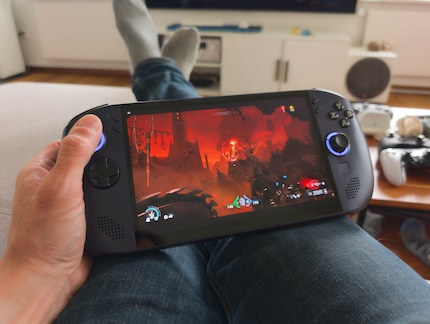
The Legion Go S can clearly stand out from the Steam Deck, even at a higher resolution. Lenovo also delivers higher fps compared to the ROG Ally X with the identical processor. This is probably less due to the larger amount of RAM (32 GB instead of 24 GB) rather than because of SteamOS, which is more resource-efficient than Windows 11.
Neither the brightest nor the most gaudy
Compared with the first Legion Go, Lenovo has come to its senses and reduced the resolution from 2560 × 1600 pixels to a more acceptable 1920 × 1200 pixels. The picture on the eight-inch IPS display is still sharp. But it doesn’t come close to the high-contrast image on the Steam Deck OLED with its perfect black levels. It’s also missing HDR. If you don’t put them side by side like I did, you’ll still be happy with it. The 500 nits are also good enough for me to play reasonably well outdoors. But here, too, it’s clearly behind the Steam Deck OLED, which achieves almost 1000 nits.
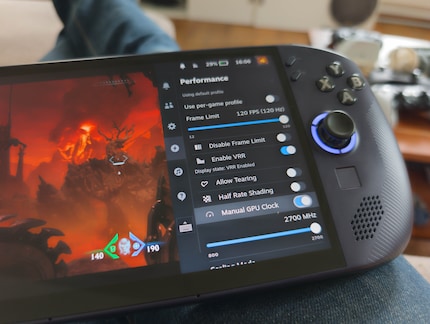
I can cope with the fact that the screen only offers 120 Hz instead of 144 Hz compared to the Legion Go. After all, it’s equipped with VRR, which improves the gaming experience with fluctuating frame rates.
However, the 2×2 watt speakers sound decent, albeit slightly tinny. I’d rather they were a bit more powerful.
Large yet portable
The Legion Go S looks chunky, and it is. Weighing 730 g, it’s one of the heaviest handhelds. Only the even larger Legion Go weighs more at 854 g. The Steam Deck OLED weighs 640 g, while the Switch 2 comes in at just 534 grammes. Nevertheless, I find the Legion Go S more ergonomic than Nintendo’s console.
The handles swing around the housing in a similar way to the Steam Deck. This lets me hold it in a relaxed grip for longer. But they also make the console bulky. Ergonomics remains a question of personal taste. The Legion Go S seems a bit unsuitable for small hands or children. For me, it ranks just behind the Steam Deck.
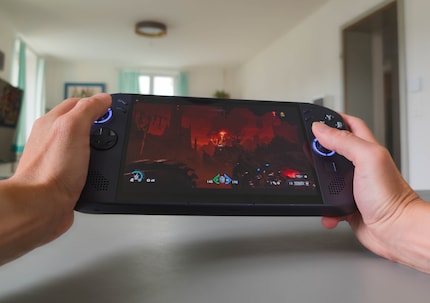
I’m only moderately satisfied with the buttons. A, B, X, and Y are a bit too flat for me and the A button has also jammed a few times. The four menu buttons are functional, but don’t click in a very satisfactory way. Meanwhile, the shoulder buttons sound very loud and hollow. There’s no premium feeling here. I can shorten the stroke distance of the trigger buttons using a control on the back. This is an advantage in action games that require quick reactions.
There are also two additional buttons on the back that are perfectly positioned for my middle fingers. Nevertheless, I’d still have liked two more, like the Steam Deck offers.
One disappointment is the small square below the right analogue stick, which looks like a fingerprint scanner but is actually a touchpad. It’s nice that Lenovo has understood that this is part of the standard equipment on a PC handheld. However, its paltry size and lack of precision make it practically useless for gaming. I only use it in desktop mode when I need to select something.
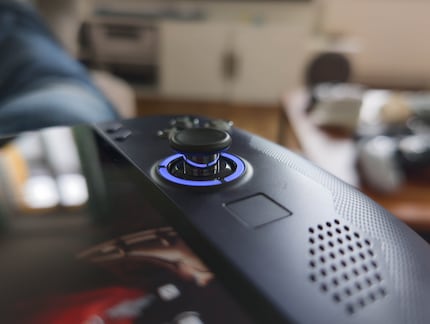
Not the quietest or most long lasting
You can clearly hear the fan in the performance profile that delivers the handheld’s maximum performance. While there’s no annoying whistling, in quiet surroundings and without loud music, the noise can be disturbing. Both the Steam Deck and ROG Ally X are quieter and take longer for me to notice the fan.
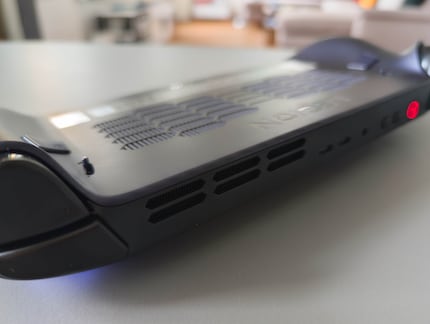
The battery boasts 55.5 watt hours (Wh), which is slightly more than the Steam Deck that has a smaller display and a lower resolution. The Ally X offers an impressive 80 Wh. As a result, the battery performance of the Legion Go S isn’t outstanding. Cyberpunk 2077 lasts just under 90 minutes at maximum brightness. Meanwhile, the ROG Ally X lasts 10 minutes and the Steam Deck OLED can manage 40 minutes longer.
In a nutshell
The favourite child
You should treat all your children equally. But when I look at the two Legion Go S siblings, I have to give precedence to the SteamOS version. Sorry, Windows, I love you too, but unfortunately you have to stay at home.
Not only do most games run faster, the user experience is also much better than with Microsoft’s operating system. I’d be interested to see what ROG Xbox Ally comes up with this year. Until then, the Legion Go S is one of the best PC handhelds on the market.
Despite its considerable size, this gaming device remains reasonably manageable. The IPS display isn’t the brightest and can’t handle HDR, but it reacts quickly and offers VRR. The battery could have been a bit more powerful, but you still get a lot of handheld for your money. If you want real touchpads and can compromise a bit on performance, the Steam Deck remains the best alternative. Or you can wait and see what the Legion Go 2 delivers. That even boasts an OLED screen.
Pro
- SteamOS pre-installed
- Faster than the Windows version
- Reasonably portable
Contra
- Won’t win any design awards
- Touchpad that’s almost unusable
- Moderate battery performance
- No OLED or HDR

As a child, I wasn't allowed to have any consoles. It was only with the arrival of the family's 486 PC that the magical world of gaming opened up to me. Today, I'm overcompensating accordingly. Only a lack of time and money prevents me from trying out every game there is and decorating my shelf with rare retro consoles.
